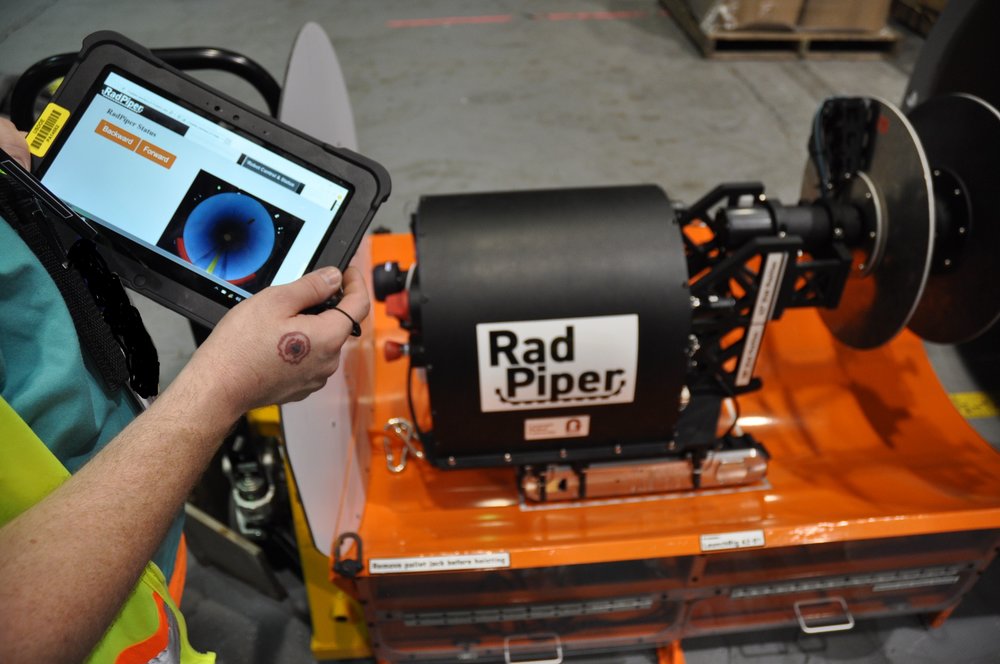
PCAMS is robotic pipe measurement coupled with automated analysis and reporting to accelerate quantification of uranium-235 deposits (U-235). Radiometry, reporting, archiving, and task commissioning are not individually remarkable. Together as a system and fully integrated with a decommissioning site’s procedures it holds value that far, far exceeds the sum of its parts. PCAMS is our integration of RadPiper, the detector assembly, and the Post-Processing Software to autonomously measure and report U-235 deposits in uranium enrichment piping.
What is RadPiper?
RadPiper is a pipe-crawling robot specialized for autonomous measurement of U-235 deposit within uranium enrichment piping. A detector assembly is mounted on the front to give RadPiper radiometric data. RadPiper is battery-powered and tetherless and self-steers using two tracks. RadPiper also safeguards against end-of-pipe conditions and obstacles in the pipe making it fully autonomous upon launch.
Why Measure U-235 Deposits?
Vast amounts of U-235 remain in miles of piping that once enriched America’s uranium. These immense facilities are now defunct and decommissioning is underway. An immense driver of decommissioning schedule and budget is a requirement to determine the exact grams of U-235 in every foot of that pipe before demolition.
To date, human workers in protective clothing have manually deployed detectors from the outside of these pipes to observe radiation emanating from the U-235 inside the pipes. This incurs operational disadvantages of clearing around pipes for access, hazards of elevated work, rad exposure, and manual data transcription. The technical disadvantages include faint signal from attenuation through pipe walls, inability to directly view the deposits, and inability to position a detector on the pipe’s center-line.
The real crux of measurement is the transcription of data, analysis, reporting, review and archiving that follows the data gathering. Data is transcribed, analyzed by humans, and reported in documents that are also manually generated. The method is subject to blunders, misinterpretations, costs, and long reporting delays.
Why Automate?
Since decommissioning involves cutting pipes, the unique opportunity is to robotically deploy detectors from the inside rather than the outside to measure per-foot quantities of U-235. The compelling advantages derive from in-pipe measurement:
- Doesn’t require demolition for clear access around pipes.
- Precludes significant elevated work for NDA personnel.
- Achieves superior speed, accuracy, and certainty versus external, through-wall methods.
- Data is machine-generated for automatic screening, reporting and archiving.
- In addition to radiometry, provides video and geometric record of deposit.
- Out-and-back driving generates redundant measurement.
- Achieves vast schedule and budget economy for D&D of uranium enrichment sites.
How Does a Robot Measure U-235 Deposits in Pipe?
A pipe-crawling robot measures U-235 from the inside of a pipe, and measures exactly where U-235 is located along the pipe.
A radiation detector acquires spectra of the gamma rays emitted by a foot-long segment of U-235 deposits on the pipe wall. The detector is shielded to limit detection to foot-long segments of pipe. The robot autonomously steers precisely along the pipe’s centerline and maintains the exact travel speed required for the radiation measurements.
The robot precisely models the geometry of the deposits on the pipe walls to aid in calculation of the U-235 content within the deposits and acquires quality images of the pipe to aid in analyzing the deposits. The robot’s odometry precisely tags all the radiation, geometry, and visual information correlates this to its accurate location along the pipe.
Post-Processing integrates all this data to compute the grams of U-235 in each foot of a pipe’s length.
What is Disc-Collimated Radiometry?
Determinations of uranium inventory and criticality incredibility are measured as grams of U-235 per foot. Disc-Collimated detection is the innovative means to quickly, accurately and directly measure exactly the quantity of interest: grams of U-235 per foot. The great advantage is positioning the detector exactly on a pipes center-line. This gives an axisymmetric field of view at constant radius to the pipe’s wall. A pair of lead discs bracket the detector limiting the field of view to a single foot of length along the pipe wall. The detector assembly is carried forward of the robot so that tracks and body do not protrude into the field of view.
current student
current staff
current head
past student
- Matthew Hanczor





